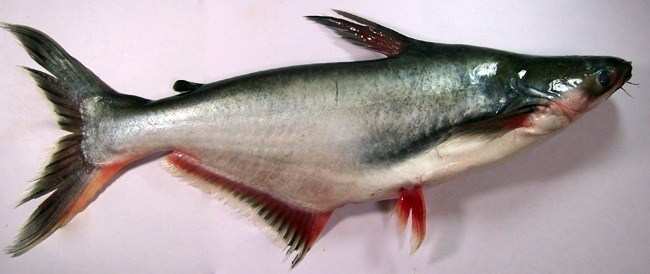Exotic fish Pangas may hamstring aquatic biodiversity of Mahi River System
Fearing from what happened at Jaisamand Lake few years back with the introduction of the dangerous Tilapia Fish there, Limnologists worry that introduction of exotic Pangas (Pangasius sutchi or Pangasionodon hypophthalmus) in Mahi Bajajsagar dam in Banswara district may shatter the unique food web of aquatic biodiversity and fish fauna of this fluviatile ecosystem.

Fearing from what happened at Jaisamand Lake few years back with the introduction of the dangerous Tilapia Fish there, Limnologists worry that introduction of exotic Pangas (Pangasius sutchi or Pangasionodon hypophthalmus) in Mahi Bajajsagar dam in Banswara district may shatter the unique food web of aquatic biodiversity and fish fauna of this fluviatile ecosystem.
Earlier in 1990s on account of stocking of contaminated fish seed from West Bengal, Tilapia fish has got entry in the Jaisamand Lake of Udaipur and after firm establishment it is now adversely affecting the age old carp fisheries in this prestine water body. Pangas is a candidate species for the Cage culture Project initiated recently by the State Fisheries Department at Mahi Bajaj Sagar Dam under the technical supervision of the Central Inland Fisheries Research Institute(CIFRI), Barrackpore, West Bengal. A battery of several fish holding nylon net cages has been floated in the dam for aquaculture with the funding of Rs 2 crores from the Union Government. As per the recommendation of CIFRI fingerlings of exotic Pangas have to be stocked in cages at high density of 2000-2500 per cage. Meanwhile, large quantity of feed pellets have also been procured by the state fisheries department.
Pangas or ‘Striped cat fish’ as known popularly, this fish is native to rivers of Cambodia and Vietnam which has been introduced in many countries for aquaculture. Once introduced, the fish has been reported to establish in the wild in many countries. This fish is known to grow fast and attains weight of 1 Kg in a period of 3 months that is why considered suitable for cage culture at high density.
Under culture environment the fish is hardy to survive and easily accepts pelleted feed. At tender stage this fish is carnivorous and consumes gastropods and insects whereas the adult fish has relatively wider feeding spectrum being an omnivore thus consuming a variety of food available in water. Obviously, they would compete with other fishes present in the ecosystem. Pangas attains sexual maturity in three years when it weigh 4 to 6 Kg and has potential to spawn in natural riverine environment as these are dwelling in rivers. The reported high growth rate of Pangas is due to its high Food Conversion Ratio (FCR).
Fisheries experts have expressed fear of accidental escape of Pangas from cages to the main reservoir and ultimately into the entire Mahi River System comprising of many tributaries such as rivers Som, Banas and Panam flowing through Rajasthan and M.P., and ultimately draining into the Gulf of Khambhat via Gujarat. Such accidental escape is evident from a similar project running presently in Sarodha Reservoir of Kawardha, Chattisgarh due to heavy winds and subsequent damage to net cages, said Dr L.L. Sharma, a Limnologist and Former Dean at the Fisheries college in Udaipur. Incidence of escape of this fish into wild habitats have also been on record in several wetlands of West Bengal and Kolleru lake of A.P. besides many water bodies of Kerala and Uttar Pradesh. Pangas is also reported to carry certain infectious diseases which can be transmitted to other local fishes occurring in the wild. Considering these facts, therefore, the possibilities of escape into Mahi Bajaj Sagar and associated river system cannot be ruled out.
The Environmental aspect of cage culture is yet another pertinent issue as in intensive cage culture uneaten food, chemicals and drugs may enter in reservoir from cage to create problem for the wild stock of fish and other aquatic organisms which are integral components of aquatic biodiversity-food web complex. Such undesirable contaminations may also deteriorate water quality, accelerate eutrophication and may pose threat to public health, Sharma opined.
In his suggestions to the fisheries authorities, Sharma has prescribed use of Rohu, Catla & Mrigal or any commercially important local cat fishes as alternative species for the proposed cage culture. However the officials of the fisheries department have ruled out possibilities of the fish posing threat to the river system. This kind of projects are ongoing successfully at many places and utmost care would be taken that there would be no slip, said Radha Mohan Srivastav, the Deputy Director of Fisheries department. The fish do not breed inside the river system and they will be cultivated insides cages, hence there is no cause for fear at all, he reaffirmed.
Story by Geetha Sunil Pillai
To join us on Facebook Click Here and Subscribe to UdaipurTimes Broadcast channels on GoogleNews | Telegram | Signal


